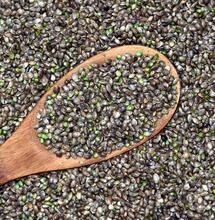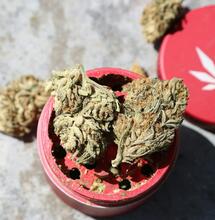Plant Nutrient Solutions

Just like humans, plants also require sustenance to thrive and flourish. Here is a little background on how marijuana plants eat, and why.
Just like humans, plants also require sustenance to thrive and flourish. Here is a little background on how marijuana plants eat, and why.
Plants take up nutrients from the growing medium and use them in a variety of ways to live and grow. As the available nutrients in the growth medium are transferred into the plant, the amount remaining in the medium decreases. While the nutrients are being used up from the growth medium, they should be replaced to insure that enough - but not too much - is available to the root system for uptake.
|
Cooking implements can be handy for measuring nutrients |
Why Do We Need to Feed Our Cannabis Plants?
In nature, these nutrients are supplied by the nearby decomposition of plant material, such as fallen leaves, vegetation that has completed its life cycle and has died, animal waste (and eventually the animals themselves, after they die and are scavenged of fats and meat), as well as mineral content in the soil.
When a gardener removes the plant from its natural surroundings, he or she becomes responsible for supplying any needed resources to which the plant no longer has access. Since a well-maintained container or backyard garden is kept free of debris, such as decomposing plant and animal life, the replacement nutrients must come from another source or the medium will eventually become barren. Hydroponic media generally do not have any starting nutrient value, and are entirely dependent upon this replacement nutrition, right from the start.
In order for the replacement nutrients to be useful to the plant, they must come into contact with the root system (or at least within mycorrhizal reach).
Plants also necessitate that moisture is available to the root system, because water is required for photosynthesis. Light energy is absorbed by the plant, which divides the water molecules into hydrogen and oxygen. The hydrogen is combined with carbon dioxide (CO2) to form sugars necessary for plant growth.
Cannabis Nutrient Solutions and Top Dressings
Since plants need both water and nutrients, it is common to dissolve the nutrients (the solute) into water (the solvent) to create a nutrient solution. Organic nutrients are often less miscible and should be shaken to create a suspension before use. If the material does not actually dissolve into the water, it is technically a mixture and not a solution, but still tends to fall under the term 'nutrient solution'.
In a recirculating system, the nutrient solution is replaced periodically, both to re-balance the mix of available nutrients, and to remove any leftover salts or contaminates in the solution.
'Top dressing' is used to describe the act of placing material with nutrient value on top of the existing grow medium, and watering from above to wash the replacement nutrients to within range of the root system. In practice, it is common to at least occasionally water the plants with plain water, in part to help wash away any accumulating salts from the growth medium.
|
These bags contain dry ammonium sulfate, ammonium dihydrogen phosphate and kelp for use as nutrients. High concentrations indicate that only small amounts should be used |
How Do Cannabis Nutrient Solutions Work?
Nutrient solutes are frequently hydrophilic ('water-loving') salts of nitrogen (N), phosphorus (P), and potassium (K) in water. These salts tend to dissolve easily in water because water molecules have a positive charge on the side with the two hydrogen (H) atoms, and a negative charge on the oxygen (O) side; these are attracted and attach easily to many other molecules. Salts are often used as nutrient sources because they also have a positive and negative side, but are generally held together with a weaker ionic bond. Water molecules attach themselves to either side of the salt molecule, and literally split them apart.
If your local tap water is of low quality, a reverse-osmosis (RO) filter or other filtration system can be used to clarify and clean the water before garden application.
There are several nutrient manufacturers producing concentrated nutrient solutions that can be mixed with water and applied. It is also possible to obtain the component ingredients and mix a solution of your own choosing, although more technical expertise is required in order to avoid nutrient imbalances - much like baking a cake from a box versus making one from scratch; the from-scratch cake offers more flexibility but at the cost of risking success.
Do not mix full-strength concentrates together prior to adding them to water. When mixing a nutrient solution that has more than one concentrate added to it, make sure to add the concentrates individually to the solvent (the water) and briefly stir between additions.
Why Are Electrical Conductivity (EC) and Parts per Million (PPM) Important?
Pure water does not conduct electricity, but once conducive materials such as salts are introduced, a nutrient solution will. If a little conductive material is added, a little conductivity results; the more conductive material is added, the better the solution conducts electricity. Meters are the most effective way to estimate nutrient levels when salt-based fertilizers are used, since adding salts tends to increase conductivity. These meters are much less useful when using non-salt-based organic fertilizers. Total dissolved solids (TDS) meters measure this property in order to estimate nutrient levels, displaying their information as on either the EC scale or on one of the PPM scales.
PPM meters use the same principle; in fact, they are practically the same meter, except for the results being displayed slightly differently. There is currently an issue with the lack of a standard conversion between EC and PPM, which often leads to confusion. The conversion factor is either 0.5, 0.64 or 0.7, depending upon which of the three most popular PPM standards is used. When following manufacturer-recommended PPM levels, make sure to use the scale for which the chart was written.
|
Air is pumped into nutrient solutions to keep it from going stale |
Maintaining Dissolved Oxygen Content
Nutrient solutions also require a suitable amount of available oxygen. The level of freely-available oxygen in water is known as its dissolved oxygen (DO) content. The amount of air that water will hold is dependent upon temperature - the warmer the water is, the less air it will hold and the more important additional aeration becomes. If the amount of dissolved oxygen drops too low, the water will go stale and create conditions for anaerobic ('air-hating') bacteria to develop. Anaerobic bacteria are the rotting and spoilage bacteria responsible for the foul odors in stagnant water. Air stones and drippers are two ways to increase the amount of dissolved oxygen.
Nutrient solutions can be as simple as following directions on a bottle, or as complicated as a gardener would like to make them. The primary requirement in any feeding regimen is how well the plants perform with use, although other factors, such as cost-effectiveness, should also be considered.
Peace, love and puka shells,
Grubbycup



